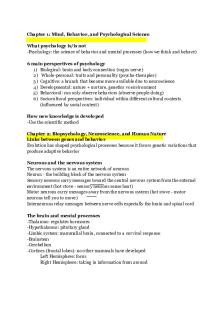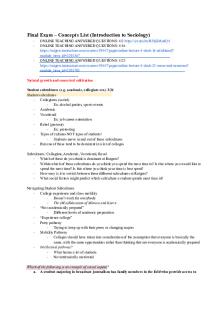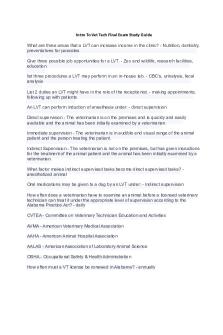Exam 2 Study Guide Intro to Business PDF

| Title | Exam 2 Study Guide Intro to Business |
|---|---|
| Author | Hope Miller |
| Course | Introduction To Business |
| Institution | Angelo State University |
| Pages | 4 |
| File Size | 80.3 KB |
| File Type | |
| Total Downloads | 75 |
| Total Views | 128 |
Summary
Study guide...
Description
Intro to Business - Exam 2 Study Guide Chapter 5 What are the major advantages and disadvantages of a sole proprietorship? Advantages—Ease of starting and ending the business, Being your own boss, Pride of ownership, Leaving a legacy, Retention of company profit, and No special taxes Disadvantages—Unlimited liability (any debts or damages incurred by the business are your debts, even if it means selling your home, car or anything else), Limited financial resources, Management difficulties, Overwhelming time commitment, Few fringe benefits, Limited growth, and Limited life span What are the major advantages and disadvantages of a partnership? Advantages—More financial resources, Shared management and pooled/complementary skills and knowledge, Longer survival, and No special taxes Disadvantages—Unlimited liability, Division of profits, Disagreements among partners, and Difficult to terminate What is a general and limited partnership? General Partnership—all owners share in operating the business and in assuming liability for the business’s debts General Partner—an owner (partner) who has unlimited liability and is active in managing the firm Limited Partnership—a partnership with one or more general partners and one or more limited partners Limited Partner—an owner who invests money in the business, but enjoys limited liability (liability for the debts of the business is limited to the amount the limited partner puts into the company; personal assets are not at risk); cannot actively manage What are the major advantages and disadvantages of a corporation? Advantages—Limited liability, Ability to raise more money, Size, Perpetual life, Ease of ownership change, Ease of attracting talented employees, and Separation of ownership from management Disadvantages—Initial cost, Extensive paperwork, Double taxation, Two tax returns, Size, Difficulty of termination, and Possible conflict with stockholders and board of directors ***Anyone can incorporate ***Major advantages are limited liability and possible tax benefits for individuals Which is the most common form of business ownership? Sole Proprietorships (72%) What is the owner of a corporation called? Stockholders What are the 3 types of mergers? Be familiar with examples of all 3. 3 Types of Mergers: Vertical Merger—the joining of two firms in different stages of related businesses; Ex: soft drink company buys artificial sweetener company; HEB buys bakery Horizontal Merger—the joining of two firms in the same industry with different products; Ex: soft drink company buys mineral water company Conglomerate Merger—the joining of firms in completely unrelated industries;
Ex: soft drink company buys snack food company Why do companies participate in mergers and acquisitions? Merger—the result of two firms joining to form one company; A + B = C Acquisition—one company’s purchase of the property and obligations of another company Companies participate in mergers and acquisitions to; a + b = A To expand within their field and increase profit What is franchising? What is the most popular type of business for franchising? Franchise Agreement—an agreement whereby someone with a good idea for a business (franchisor) sells the rights to use the business name and sell a product or service (franchise) to others (franchisees) in a given territory Most popular type of business for franchising—restaurants and gas stations with a convenience store What is the most popular target for US-based franchises? Canada ***Corporations make up 20% of all businesses, but take 80% of all revenue Chapter 6 Define entrepreneurship. Accepting the risk of starting and running a business Why do entrepreneurs accept the risks of business ownership? Opportunity Profit Independence Self-Satisfaction Challenge What are the personality traits of entrepreneurs? Self-directed Self-nurturing Action-oriented Highly energetic Tolerant of uncertainty What is an entrepreneurial team? Be familiar with example of such a team. A group of experienced people from different areas of business who join to form a managerial team with the skills to develop, make, and market a new product (EX: An entrepreneurial team (Steve Jobs, Steve Wozniak, and Mike Markkula) was key to Apple’s success; Small businesses conceive develop and market their own products What is an (business) incubator? Offer new businesses low-cost offices with basic services Be familiar with interesting statistics about small businesses. 28 million small businesses in the U.S. Of all nonfarm businesses in the U.S. almost 97% are considered small Small businesses account for over 50% of GDP Small businesses have generated 65% of all new jobs since 1995 Be familiar with the analogy of the hole in the ground and boulders/pebbles.
You dig a hole in the ground, and you fill it up with boulders—hole is not full—still cracks; there is still room for pebbles; boulder can build the hole, but the entrepreneur will fill in Why do many small businesses fail? Lack of financial support Lack of managerial planning What does a business plan contain? A detailed written statement that describes the nature of the business, the target market, the advantages the business will have over the competition, and the resources and the owner’s qualifications; marketing, financial, and operating strategies too What document is necessary for entrepreneurs to have in order to talk with bankers? Business plan What is the SBA? Small Business Administration; A U.S. government agency that advises small businesses by providing management training and financial advice; encourages small business development ***Most people start their own business to make lots of money—FALSE ***You don’t need a lot of money to start a business—TRUE ***It is important to have a great idea—FALSE ***The bigger the risk the bigger the reward—FALSE ***Successful entrepreneurs are born to have their own business—FALSE ***If you haven’t started a business by the time you are 30, you are too old—FALSE ***You don’t usually need a business plan to attract potential investors—FALSE ***It is better to be creative than self-disciplined—FALSE ***It is smarter to focus on the big picture instead of business details—????? ***Most entrepreneurs are ethical people—TRUE ***Small business relative to industry Chapter 7 Define management. Be familiar with the activities involved in four functions of management. The process used to accomplish organizational goals through planning, organizing, leading and controlling people and other organizational resources Four functions of management: Plan (looking at the market forecast to identify future business opportunities and challenges), Organize (design the structure to put the right people in the right places), Lead (guiding and motivating employees to work effectively to accomplish organizational goals and objectives), and Control (taking correction action when necessary) Define vision and mission statement. Vision—more than a goal, it’s a broad explanation of why the organization exists and where it’s trying to go Mission Statement—outlines the organization’s fundamental purposes. It includes: the organization’s self-concept, its philanthropy, long-term survival needs, customer needs, social responsibility, and the nature of the product or service What is a SWOT analysis? Analyzes the organization’s Strengths, Weaknesses, Opportunities, and Threats; helps to get to our goal through strategic planning, tactical planning, operational planning, and contingency planning Be familiar with the differences between strategic, tactical, and operational planning. Strategic Planning—looks at the organization as a whole; long-range goals
Operational Planning—day to day operations Tactical Planning—the identification of specific, short-range objectives by lower-level managers Contingency Planning—backup plan Why should organizations develop contingency plans? In case the original plan fails What are the steps in the rational decision-making model? 1. ***Define the situation*** 2. Describe and collect needed information 3. Develop alternatives 4. Decide which alternative is best 5. Do what is indicated 6. Determine whether the decision was a good one and follow up Be familiar with the different levels of management. Top Management—President/Vice President (strategic planning) Middle Management—Plant managers, Division heads, Branch management (operational planning) Supervisory Management—directly responsible for daily performance (first line managers) Be familiar with the tasks and skills required at different levels of management. Top Management— Technical Skills, Human Relations Skills, Conceptual Skills Middle Managers—Technical Skills, Human Relations Skills, Conceptual Skills First-Line Managers—Technical Skills, Human Relations Skills, Conceptual Skills What are keys to effective leadership? Communicate a vision and rally others around that vision, establish corporate values, Promote corporate ethics, Embrace change, Stress accountability and responsibility HONESTY When would an autocratic style of leadership be more effective? Making managerial decisions without consulting others; when you have a vision that you do not want to be messed up; emergency situation/new/unexperienced employee When would a free-rein style of leadership be more effective? Managers set objectives and employees are free to do whatever is appropriate to accomplish those objectives; a university with professors What is controlling? 1. Establishing clear standards 2. Monitoring and recording performance 3. Comparing results against standards 4. Communicate results 5. If needed, take corrective action In setting standards in the control process, what characteristics should they have? Specific, Measurable, and Attainable...
Similar Free PDFs

Intro to Biology Exam 2 study guide
- 11 Pages

Chapter 2 - intro to business
- 31 Pages

Notes intro to business
- 3 Pages

Exam 2 Study Guide
- 32 Pages

Exam 2 Study Guide
- 5 Pages

Exam #2 Study Guide
- 4 Pages

Exam 2 study guide
- 29 Pages
Popular Institutions
- Tinajero National High School - Annex
- Politeknik Caltex Riau
- Yokohama City University
- SGT University
- University of Al-Qadisiyah
- Divine Word College of Vigan
- Techniek College Rotterdam
- Universidade de Santiago
- Universiti Teknologi MARA Cawangan Johor Kampus Pasir Gudang
- Poltekkes Kemenkes Yogyakarta
- Baguio City National High School
- Colegio san marcos
- preparatoria uno
- Centro de Bachillerato Tecnológico Industrial y de Servicios No. 107
- Dalian Maritime University
- Quang Trung Secondary School
- Colegio Tecnológico en Informática
- Corporación Regional de Educación Superior
- Grupo CEDVA
- Dar Al Uloom University
- Centro de Estudios Preuniversitarios de la Universidad Nacional de Ingeniería
- 上智大学
- Aakash International School, Nuna Majara
- San Felipe Neri Catholic School
- Kang Chiao International School - New Taipei City
- Misamis Occidental National High School
- Institución Educativa Escuela Normal Juan Ladrilleros
- Kolehiyo ng Pantukan
- Batanes State College
- Instituto Continental
- Sekolah Menengah Kejuruan Kesehatan Kaltara (Tarakan)
- Colegio de La Inmaculada Concepcion - Cebu








